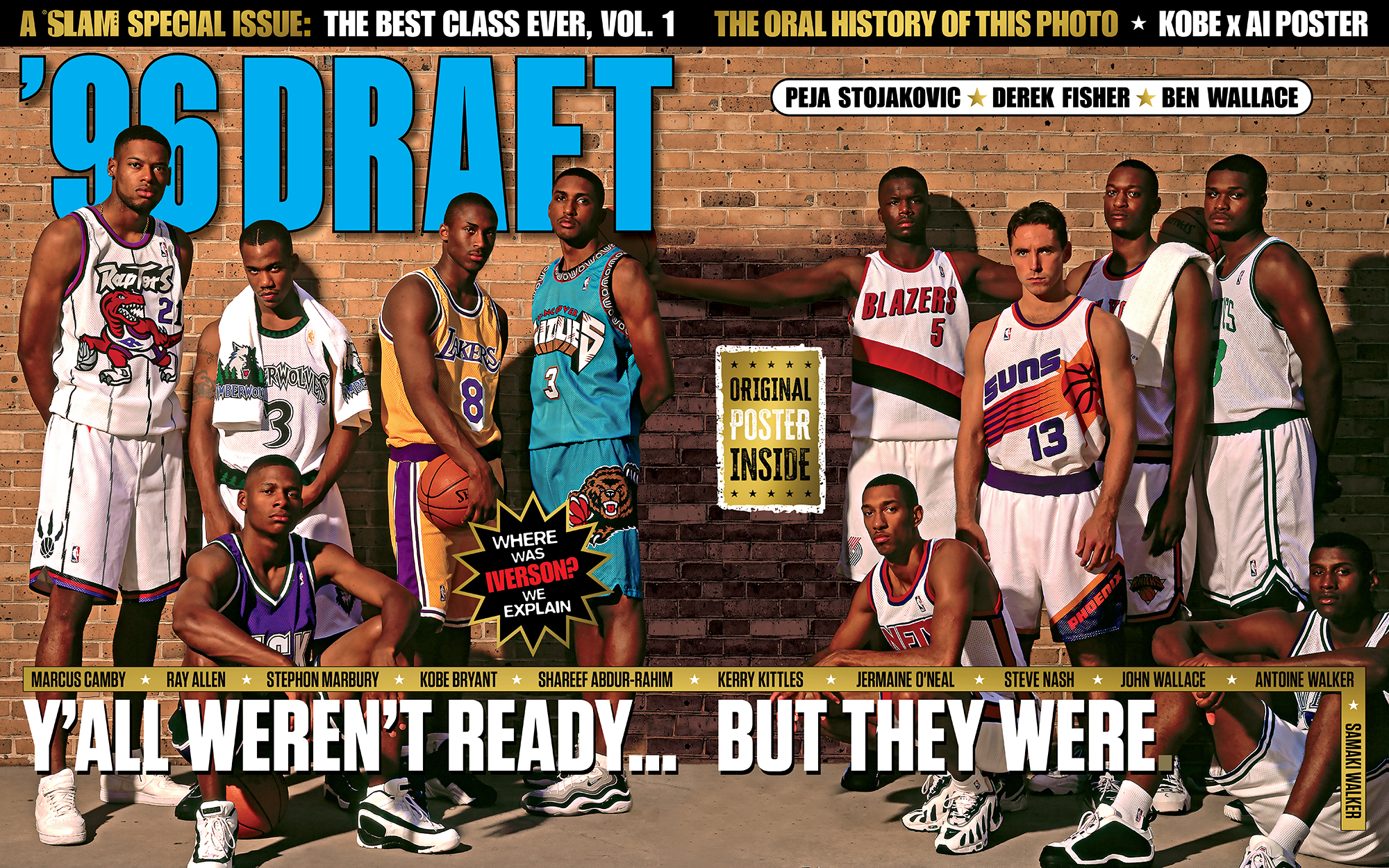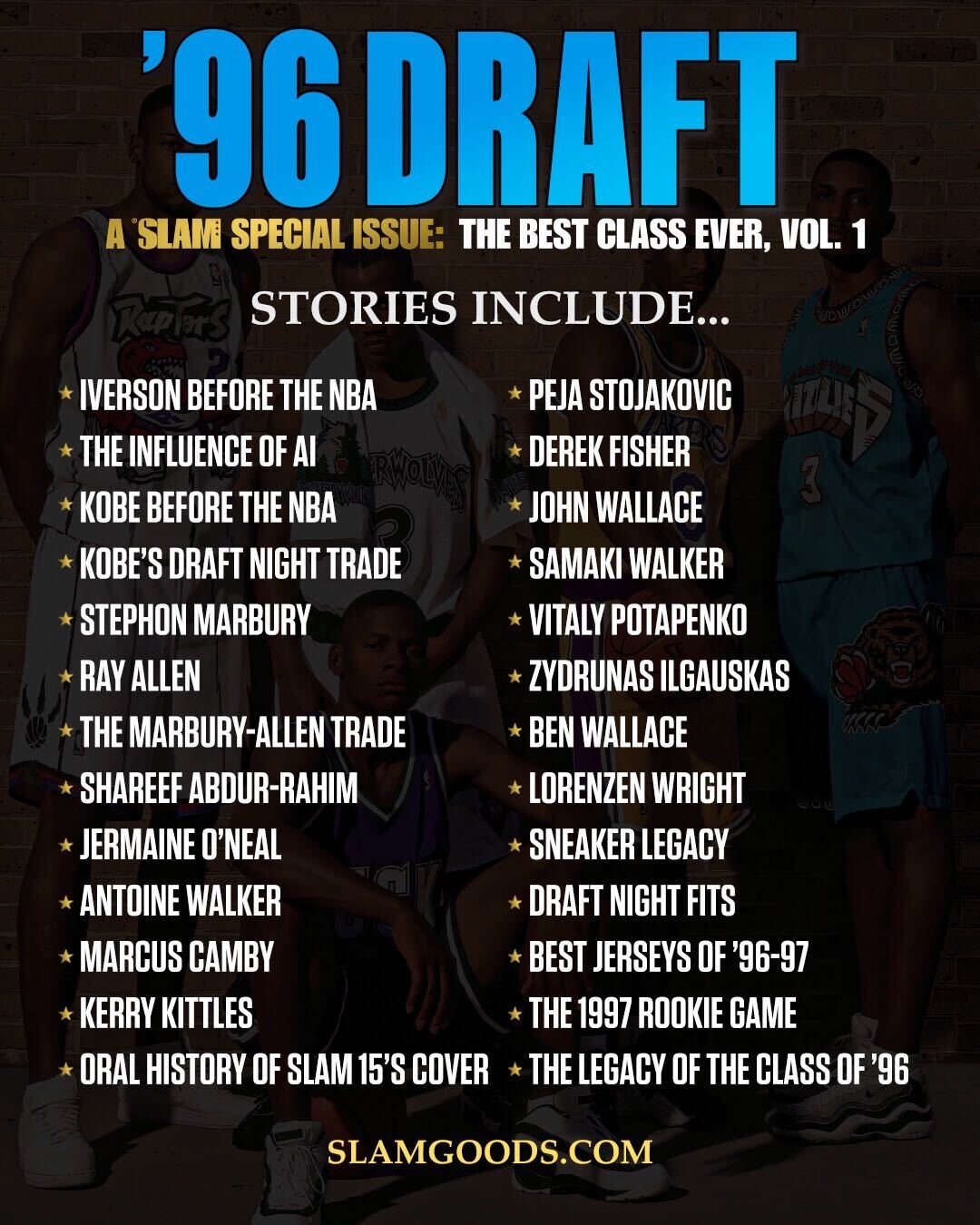This story appears in a magazine dedicated to the most iconic draft class ever. Get your copy.
Stephon Marbury was always one of Ray Allen’s biggest fans.
Their relationship goes back to the late 1980s, when they were both establishing themselves as rising stars on the court. Allen was a few years older, but they still overlapped at camps and showcases, striking up a bond. The respect was mutual. The love for the game was shared. They knew their paths would be crossing for a long time.
“Ray and I were really good friends from when I was in 8th or 9th grade,” Steph says. “Ray was at the Nike All-American camp and they didn’t pick him to be one of the top 20 players and I was crying because they didn’t pick him. I was that mad. I swear to God. I was so mad they didn’t pick him that I was crying to him, like, Man, it’s messed up. They should’ve picked you, man. You’re one of the best players. How are you not going to be on the team? It’s all politics. It’s crazy.”
Marbury recognized the talent in Allen immediately, and vice versa. As teenagers chasing that dream of the NBA, they might’ve envisioned one day facing off in the League. But they couldn’t possibly have predicted becoming pros at the same time, in the same historic draft class, and being traded for each other before ever suiting up at the highest level.
While Allen was putting the finishing touches on a stellar UConn career in 1995-96, winning Big East Player of the Year, Marbury was taking over the ACC as a freshman at Georgia Tech. By the end of that season, it was clear that both guys were more than ready for the NBA.
GRAB YOUR COPY OF SLAM PRESENTS ’96 DRAFT FOR EVEN MORE GOODIES FROM THE ISSUE.
The Milwaukee Bucks selected Marbury with the No. 4 pick in the ’96 Draft. The Minnesota Timberwolves took Allen just after, at the No. 5 spot. Ray was shocked when it happened, having passed up an invitation to visit with Minnesota because they already had a solidified two-guard in JR Rider. When Marbury went fourth, he was sure he was headed to Boston at No. 6—a prospect he was thrilled about. Celtics president Red Auerbach had called Allen beforehand and let him know that if he was still on the board when their time came, they’d grab him.
“So Minnesota’s on the clock and the cameras come over to my table. I was so confused, I couldn’t believe what was happening,” Allen says. “I was angry. I was like, Why would you pick me when you have JR Rider already on your roster?
“[After I was picked,] I go in the back and I’m having a conversation with people from Minnesota, their local news stations,” he continues. “I’m over here filibustering on what it’s going to be like with JR Rider. I didn’t know how it was going to work. It just didn’t make sense to me. And within five minutes into those conversations, somebody from the NBA removes me and says that I’ve been traded to Milwaukee.”
Sure enough, Commissioner David Stern soon retook the stage to announce that Stephon and Ray were being swapped, with Minnesota also sending Milwaukee a 1998 first-rounder. It was among the biggest draft-day moves in League history and its core members had very different reactions to it.
“Everybody in Milwaukee at the time is booing the trade,” Allen recalls. “The media is asking me all these questions and letting me know that they’re booing the trade. I was so depressed on a day that I felt was supposed to be the happiest time of my life. I felt so frustrated, confused, disappointed. I laugh about it now, but it was such a rollercoaster of emotions at the time and I thought I should’ve been happier than I actually was.”
“I didn’t care,” Marbury says, reflecting back. “I was in the NBA. It didn’t matter. I basically was talking about playing with Glenn Robinson and Vin Baker, and then I was talking about playing with Kevin Garnett. That’s what happened.”
The deal meant that Steph was reuniting with KG, a longtime friend who was the same age but had jumped directly from high school to the pros as the No. 1 pick in 1995. Led by that dynamic duo, the T-Wolves made the playoffs right away. Marbury was named to the All-Rookie First Team, averaging 15.8 points and 7.8 assists.
For two and a half seasons, Garnett and Marbury were one of the most electrifying 1-2 punches in the Association. Then Stephon, who wasn’t fond of living in Minnesota and expressed his desire to be elsewhere, was traded to the New Jersey Nets. (Coincidentally, that three-team trade included Allen’s Bucks, who received Sam Cassell, Paul Grant and Chris Gatling.) He became a two-time All-Star and went on to play in China, where he claimed three CBA titles and an MVP award.
Out in Milwaukee, Allen had an immediate impact as well. He was with the franchise for nearly seven seasons, making three All-Star Games and three playoff appearances. In 2000-01, he guided the team to a 50-win campaign and a battle with Allen Iverson’s 76ers in the Eastern Conference Finals. The Bucks sent him to Seattle in February of 2003, ushering in a new chapter that eventually led him to multiple championships—one of which was ironically won alongside Garnett in Boston.
The truth is, regardless of where they ended up, Marbury and Allen were bound to thrive. Their intertwined paths were headed in the exact same direction. In retrospect, it’s hard for either guy to have any regrets or ponder different journeys than the successful ones they’ve followed. Long before basketball became a business, they foresaw that success in each other.
There’s one score that they’ve never settled, however.
“To this day, I tell Stephon that he owes me 200 grand,” Allen says with a smile, “because that was the difference in salary from the fourth to the fifth pick.”
—

